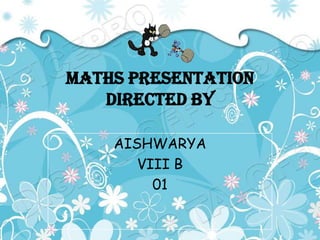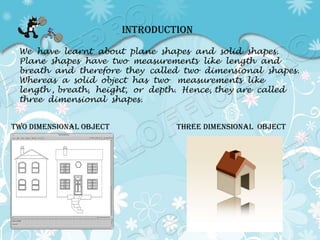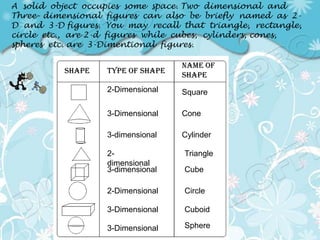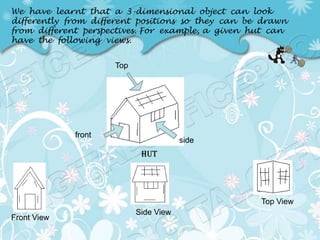Maths presentation
- 1. Maths presentation directed by AISHWARYA VIII B 01
- 3. introduction We have learnt about plane shapes and solid shapes. Plane shapes have two measurements like length and breath and therefore they called two dimensional shapes. Whereas a solid object has two measurements like length , breath, height, or depth. Hence, they are called three dimensional shapes. Two dimensional object Three dimensional object
- 4. A solid object occupies some space. Two dimensional and Three- dimensional figures can also be briefly named as 2- D and 3-D figures. You may recall that triangle, rectangle, circle etc., are 2-d figures while cubes, cylinders, cones, spheres etc. are 3-Dimentional figures. name of shape type of shape shape 2-Dimensional Square 3-Dimensional Cone 3-dimensional Cylinder 2- Triangle dimensional 3-dimensional Cube 2-Dimensional Circle 3-Dimensional Cuboid 3-Dimensional Sphere
- 5. A tent. A cone A tin. A cylindrical surmounted on a shell. Softy(ice-cream). A cylinder. cone surmounted by a hemisphere. A photoframe . A A boul. A hemispherical shell. Tomb on a pillar. rectangular path. Cylinder surmounted by a hemisphere. Note that all the above shapes are single. However, in our practical life, many a times, we come across combinations of different shapes. For example, look at the above objects.
- 6. views of 3-D shapes A Groove A circular path around a circular ground. A toy A rectangular field adjoining a square field. A circular A cone taken out of a cylinder. park A cross path A hemisphere surmounted on a cone.
- 7. We have learnt that a 3-dimensional object can look differently from different positions so they can be drawn from different perspectives. For example, a given hut can have the following views. Top front side hut Top View Side View Front View
- 8. Similarly, a glass can have the following views. A Glass Side View Top View
- 9. Why is the top view of the glass a pair of concentric circles? Will the side view appear different if take from some other direction? Think about this! Now look at the different views of a brick. A Brick Side view Top View Front View
- 10. We can also get different views of figures made by joining cubes. For example. Solid made of Top view Side view. Front view three cubes. Solid made up of Front view. Side view. Top view four cubes. Side view. Front view. Top view. Solid made of four cubes.











